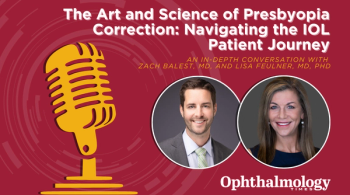
Role of dysfunctional lens in refractive lens exchange
Staging patients based on their ocular pathologies using the most advanced diagnostic tools can result in excellent image quality by precisely establishing the need for lens- or corneal-based procedures.
Due to the global aging population, a clinical staging of the aging lens symptoms will help clinicians decide on the appropriate treatment for each patient, according to George O. Waring IV, MD, FACS.
“We know we have a fabulous opportunity to help these patients, with over 2 billion people becoming presbyopic by year 2020,” said Dr. Waring, founder and medical direcor, Waring Vision Institute, Mt. Pleasant, South Carolina. “We predict that we will have an emerging sub-subspecialty of surgical correction of presbyopia because of the number of methods we have available.”
Despite the wealth of procedures available, what accompanies this recognition of a booming market is the decision-making process regarding the choice of an appropriate procedure for individual patients, he pointed out.
For corneal and lens refractive surgery, Dr. Waring has proposed an algorithym for the treatment of presbyopia based on a number of factors, including (but not limited to)-the patient's age, refractive error, lens opacity, dysfunctional lens status, topography, dry eye status, and their subjective complaints.
In their practice, the patients follow an intake track depending on the individual patient characteristics, which streamlines the process and diagnostic evaluation. This can range from aging changes to visually relevant cataract, he explained.
DLS is new
The dysfunctional lens syndrome (DLS), which may be new to ophthalmologists, includes increased ocular aberrations, presbyopia, and lens opacification. Addressing this syndrome in a staged manner, using the most advanced diagnostic tools, can help patients achieve the best image quality, which outranks the best-corrected visual acuity.
“Dysfunctional lens status is merely an attempt to characterize and standardize a triad of aging changes with the crystalline lens,” Dr. Waring said. “We know these patients become presbyopic, they have increasing higher-order aberrations, and they develop lens opacities.”
Dr. Waring then stages the dysfunctionality:
· Stage 1, loss of accommodation with a relatively clear lens, has increasing higher-order aberrations, perhaps a precataractous stage;
· Stage 2, advancing presbyopia, higher-order aberrations are present, as well as some opacification;
· Stage 3, visually relevant opacity that affects a patient’s daily life and meets the subjective and objective criteria for patients who quality for an insurance-based cataract procedure.
“This staging can help us make decisions about how best to manage these patients who are presenting for vision correction, but mostly LASIK,” Dr. Waring said. “For patients in stage 1, a corneal-based procedure might be appropriate, and for stages 2 and 3, we might perform an internal lens-based procedure.”
While treatment discussions used to be problematic, Dr. Waring said the DLS stages have simplified that process. First, the lens is evaluated with advanced ocular analysis and digital lens-centric diagnostics. Patients then are given a digital tour of their eyes rather than an animated approach. Finally, he uses the DLS grading scale as a patient education tool to guide the patients toward an appropriate treatment decision.
Surgical treatment options available include:
· Lens-based: bifocal, trifocal, extended depth of focus;
· Scleral-based: scleral spacing bands, scleral laser; and
· Cornea-based: excimer ablation, femtosecond laser, conductive keratoplasty, corneal inlays.
“They all have their relative benefits, as we’re aware,” Dr. Waring said. “The tricky part is when patients fall in between, how do we decide what’s best for them.”
Advanced diagnostics
A double-pass wavefront device, the Optical Quality Analysis System (OQAS, HD Analyzer Visiometrics), can subtract the scatter from the wavefront, depict the scatter in a ratio of unscattered light to scattered light, and then assign an objective metric, i.e., the objective scatter index. Dr. Waring sees this device as useful–more so than Snellen acuityÃ, which does not reflect visual quality, and contrast sensitivity, which he believes is not sensitive.
“Using the OQAS, we can actually look at the image quality,” Dr. Waring said. He explained how with a clear lens, a pinpoint of light has a low scatter index. This examination can be done to show how presbyopia affects the scatter index, which is expressed in a defocus curve.
Other diagnostics also can be used. For example, the Pentacam (Oculus) provides pixelated gray-scale images to assess the densitometry based on the lens opacity.
The latest ray tracing technology can separate internal aberrations from external aberrations.
Another diagnostic tool is an opacity map that correlates with cortical spokes.
Regarding the use of these tools in his clinic, Dr. Waring performs imaging, correlates the findings, and then stages the dysfunctional lens based on the clarity, image quality, and scatter, which helps in decision making when choosing between a corneal-based procedure and a lens-based procedure.
Many cases are clear-cut and the treatment path is clear. Others may be initially ambiguous.
Dr. Waring provided a case of a 55-year-old patient with a seemingly clear lens, who presented with the complaint of distortion and inquired about vision correction. Because it was possible to separate the internal from the external aberrations, the internal lens was functioning well, the dysfunctional index was “healthy,” and the aberrations were seen to be originating from the cornea and were addressed there.
In a second case, the patient’s cornea was excellent but the internal lens was not. The dysfunctional index was poor and this patient needed a lens replacement.
To evaluate this approach to treatment, he and his colleagues examined the image quality in patients who underwent a lens exchange. They found that by performing refractive lens exchange, they could cut the light scatter in half. “This cannot be accomplished by performing LASIK,” Dr. Waring emphasized.
This was also true for lens densitometry compared to a LASIK control group.
Another benefit when performing lens exchange is that the angles can be opened, which can result in decreased intraocular pressure.
“The DLS is a triad of higher aberrations, presbyopia, and lens opacity,” Dr. Waring concluded. “We can stage these patients using advanced diagnostics to facilitate making good clinical decisions because the goal is good image quality.”
George O. Waring IV, MD
This article was adapted from a presentation that Dr. Waring delivered at the 2016 American Academy of Ophthalmology annual meeting. Dr. Waring is a consultant for various ophthalmic companies.
Newsletter
Don’t miss out—get Ophthalmology Times updates on the latest clinical advancements and expert interviews, straight to your inbox.













































.png)


